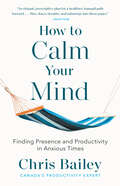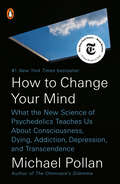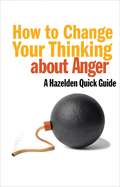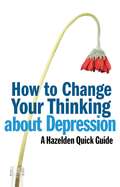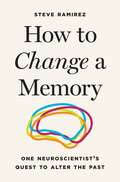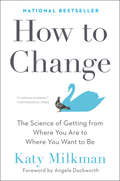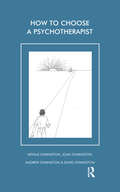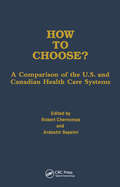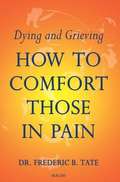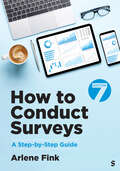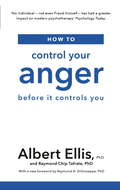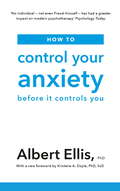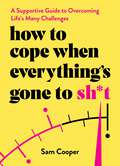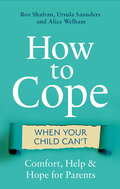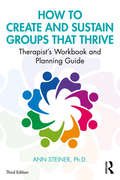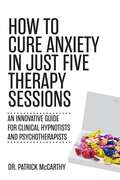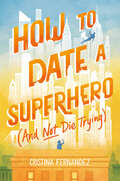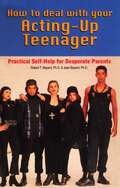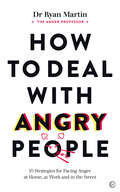- Table View
- List View
How to Calm Your Mind: Finding Presence and Productivity in Anxious Times
by Chris BaileyA toolkit of accessible, science-backed strategies that reveal that the path to a less anxious life, and even greater productivity, runs directly through calm.When Chris Bailey, productivity expert, discovered that he had become stressed and burnt out because he was pushing himself too hard, he realized that he had no right to be giving advice on productivity without learning when and how to rein things in and take a break. Productivity advice works—and we need it now more than ever—but it&’s just as important that we also develop our capacity for calm. By finding calm and overcoming anxiety, we don&’t just feel more comfortable in our own skin, we invest in the missing piece that leads our efforts to become sustainable over time. We build a deeper, more expansive reservoir of energy to draw from throughout the day, and have greater mental resources at our disposal to not only do good work, but to also live a good life.Among the topics How to Calm Your Mind covers are how analog and digital worlds affect calm and anxiety in different ways; how our desire for dopamine, a neurotransmitter in our brain that leads us to feel overstimulated, breeds anxiety, dissatisfaction, and needless stress, but can be countered by other neurochemicals; how hidden sources of stress can be tamed by a &“stimulation fast&”; and how &“busyness&” is as much a state of mind as it is an actual state of life. The pursuit of calm ultimately leads us to become more engaged, focused, and deliberate—while making us more productive and satisfied with our lives overall. In an anxious world, achieving calm is the best life hack around.
How to Change Your Mind: What the New Science of Psychedelics Teaches Us About Consciousness, Dying, Addiction, Depression, and Transcendence
by Michael PollanNew York Times Book Review 10 Best Books of 2018A New York Times Notable Book The #1 New York Times bestseller.A brilliant and brave investigation into the medical and scientific revolution taking place around psychedelic drugs--and the spellbinding story of his own life-changing psychedelic experiences When Michael Pollan set out to research how LSD and psilocybin (the active ingredient in magic mushrooms) are being used to provide relief to people suffering from difficult-to-treat conditions such as depression, addiction and anxiety, he did not intend to write what is undoubtedly his most personal book. But upon discovering how these remarkable substances are improving the lives not only of the mentally ill but also of healthy people coming to grips with the challenges of everyday life, he decided to explore the landscape of the mind in the first person as well as the third. Thus began a singular adventure into various altered states of consciousness, along with a dive deep into both the latest brain science and the thriving underground community of psychedelic therapists. Pollan sifts the historical record to separate the truth about these mysterious drugs from the myths that have surrounded them since the 1960s, when a handful of psychedelic evangelists inadvertently catalyzed a powerful backlash against what was then a promising field of research.A unique and elegant blend of science, memoir, travel writing, history, and medicine, How to Change Your Mind is a triumph of participatory journalism. By turns dazzling and edifying, it is the gripping account of a journey to an exciting and unexpected new frontier in our understanding of the mind, the self, and our place in the world. The true subject of Pollan's "mental travelogue" is not just psychedelic drugs but also the eternal puzzle of human consciousness and how, in a world that offers us both suffering and joy, we can do our best to be fully present and find meaning in our lives.
How to Change Your Thinking About Anger: Hazelden Quick Guides
by AnonymousApply practical strategies from the latest expert research to change the way you think and react to feelings of anger.Apply practical strategies from the latest expert research to change the way you think and react to feelings of anger.Do you (or does someone you know) have a problem with anger? Perhaps you've been told you do, but you're skeptical. Anger can be a healthy emotion, but when we direct it outwards towards others, or fail to use it constructively, we cause lasting damage to ourselves and loved ones.Using the research of experts in the field of emotional health, this book outlines a basic understanding of anger and offers healthy ways to process and change our thoughts, feelings, and behaviors to better deal with it. These strategies are based on Rational Emotive Behavioral Therapy (REBT), a widely used method of examining our own thoughts to challenge and change irrational beliefs.In this book, you willGet past common myths surrounding angerBreak down anger into its basic components and learn how they combine to create healthy or unhealthy expressionLearn and identify the four basic anger stylesDiscover your own anger style, and identify what triggers your angerPractice ways to respond to anger more positively by making conscious choices in your thinking, feeling, and actingKnow how and when to reach out for professional help if necessaryAbout Hazelden Quick GuidesHazelden Quick Guides are short, accessible e-books that draw on the original work and best practices of leading experts to help readers address common addiction recovery and emotional health issues. This first four-book collection applies the proven methods of Rational Emotive Behavior Therapy (REBT) to challenge and change the irrational thoughts and beliefs that contribute to the debilitating effects of shame, anger, depression, and anxiety.
How to Change Your Thinking About Anxiety: Hazelden Quick Guides
by AnonymousApply practical strategies from the latest expert research to change the way you think and react to feelings of anxiety.Apply practical strategies from the latest expert research to change the way you think and react to feelings of anxiety.Do you (or does someone you know) have problems with anxiety? Perhaps you're suffering in silence, or perhaps it's affecting your daily life and relationships. Anxiety is a common emotion, and is healthy at times. But when it keeps us from activities and people we once enjoyed, it's a disruptive and terrifying feeling.Using the research of experts in the field of emotional health, this book outlines a basic understanding of anxiety and offers healthy ways to process and change our thoughts, feelings, and behaviors to better deal with it. These strategies are based on Rational Emotive Behavioral Therapy (REBT), a widely used method of examining our own thoughts to challenge and change irrational beliefs.In this book, you willDiscover the "anatomy" of anxiety and break it down into its basic elementsLearn the different forms of anxiety so you can better care for your ownUncover your own sources of anxiety and learn how certain coping strategies often make it worseDiscover how you experience anxiety through your own thoughts, feelings, and behaviorsKnow how and when to reach out for professional help, if necessaryReclaim your life from anxiety by making conscious choices in your thinking, feeling, and acting.About Hazelden Quick GuidesHazelden Quick Guides are short, accessible e-books that draw on the original work and best practices of leading experts to help readers address common addiction recovery and emotional health issues. This first four-book collection applies the proven methods of Rational Emotive Behavior Therapy (REBT) to challenge and change the irrational thoughts and beliefs that contribute to the debilitating effects of shame, anger, depression, and anxiety.
How to Change Your Thinking About Depression: Hazelden Quick Guides
by AnonymousApply practical strategies from the latest expert research to change the way you think and react to feelings of depression.Apply practical strategies from the latest expert research to change the way you think and react to feelings of depression.Do you (or does someone you know) have problems with depression? Have you been told that you might be depressed? We all have bad days and feel down from time to time. It's common, and even healthy at times. But when these feelings linger to the point of keeping us from our responsibilities and affecting our relationships, we can feel helpless.Using the research of experts in the field of emotional health, this book outlines a basic understanding of depression and offers healthy ways to process and change our thoughts, feelings, and behaviors to better deal with it. These strategies are based on Rational Emotive Behavioral Therapy (REBT), a widely used method of examining our own thoughts to challenge and change irrational beliefs.In this book, you willDiscover the "anatomy" of depression and break it down into its basic elementsLearn the different forms of depression so you can better care for your ownUncover your own sources of depression and learn how certain coping strategies are often both a symptom and a cause of depressionDiscover how you experience depression through your own thoughts, feelings, and behaviorsKnow how and when to reach out for professional help, if necessaryReclaim your life from depression by making conscious choices in your thinking, feeling, and actingAbout Hazelden Quick GuidesHazelden Quick Guides are short, accessible e-books that draw on the original work and best practices of leading experts to help readers address common addiction recovery and emotional health issues. This first four-book collection applies the proven methods of Rational Emotive Behavior Therapy (REBT) to challenge and change the irrational thoughts and beliefs that contribute to the debilitating effects of shame, anger, depression, and anxiety.
How to Change a Memory: One Neuroscientist’s Quest to Alter the Past
by Professor Steve RamirezA disarmingly personal account of the new science of memory manipulation by one of today&’s leading pioneers in the fieldAs a graduate student at MIT, Steve Ramirez successfully created false memories in the lab. Now, as a neuroscientist working at the frontiers of brain science, he foresees a future where we can replace our negative memories with positive ones. In How to Change a Memory, Ramirez draws on his own memories—of friendship, family, loss, and recovery—to reveal how memory can be turned on and off like a switch, edited, and even constructed from nothing.A future in which we can change our memories of the past may seem improbable, but in fact, the everyday act of remembering is one of transformation. Intentionally editing memory to improve our lives takes advantage of the brain&’s natural capacity for change.In How to Change a Memory, Ramirez explores how scientists discovered that memories are fluid—they change over time, can be erased, reactivated, and even falsely implanted in the lab. Reflecting on his own path as a scientist, he examines how memory manipulation shapes our imagination and sense of self. If we can erase a deeply traumatic memory, would it change who we are? And what would that change mean anyway? Throughout, Ramirez carefully considers the ethics of artificially controlling memory, exploring how we might use this tool responsibly—for both personal healing and the greater good.A masterful blend of memoir and cutting-edge science, How to Change a Memory explores how neuroscience has reached a critical juncture, where scientists can see the potential of memory manipulation to help people suffering from the debilitating effects of PTSD, anxiety, Alzheimer&’s, addiction, and a host of other neurological and behavioral disorders.
How to Change: The Science of Getting from Where You Are to Where You Want to Be
by Katy MilkmanAward-winning Wharton Professor and Choiceology podcast host Katy Milkman has devoted her career to the study of behavior change. In this ground-breaking book, Milkman reveals a proven path that can take you from where you are to where you want to be, with a foreword from psychologist Angela Duckworth, the best-selling author of Grit.Set audacious goals. Foster good habits. Create social support. You've surely heard this advice before. If you've ever tried to change or encourage it -- to boost exercise or healthy eating, to prevent missed deadlines or kick-start savings -- then you know there are thousands of apps, books, and YouTube videos promising to help and offering sound guidance. And yet, you're still not where you want to be.This trailblazing book from award-winning behavioral scientist and Wharton Professor Katy Milkman explains why. In a career devoted to uncovering what helps people change, Milkman has discovered a crucial thing many of us get wrong: our strategy. Change, she's learned, comes most readily when you understand what's standing between you and success and tailor your solution to that roadblock. If you want to work out more but find exercise difficult and boring, downloading a goal-setting app probably won't help. But what if, instead, you transformed your workouts so they became a source of pleasure instead of a chore? Turning an uphill battle into a downhill one is the key to success.Drawing on Milkman's original research and the work of her dozens of world-renowned scientific collaborators, How to Change shares an innovative new approach that will help you change or encourage change in others. Through case studies, engaging stories, and examples from cutting-edge research, this book illustrates how to identify and overcome the barriers that regularly stand in the way of change. How to Change will teach you: • Why timing can be everything when it comes to making a change • How to turn temptation and inertia into assets that can help you conquer your goals • That giving advice, even if it's about something you're struggling with, can help you achieve moreWhether you're a manager, coach, or teacher aiming to help others change for the better or are struggling to kick-start change yourself, How to Change offers an invaluable, science-based blueprint for achieving your goals, once and for all.
How to Choose a Psychotherapist
by Neville Symington Joan Symington David Symington Andrew SymingtonThe demand for psychotherapy and counselling is greater than ever. More and more people are enrolling on psychotherapy and counselling courses; the number of different associations in this industry has doubled and everyone knows someone who is in therapy or at least thinking about it. So are standards of practice being sacrificed while we are trying to keep up with the demand? Are the right people training to be psychotherapists? Have you got the right psychotherapist?
How to Choose?: A Comparison of the U.S. and Canadian Health Care Systems (Policy, Politics, Health and Medicine Series)
by Robert Chernomas Ardeshir SepehriPart I of this book explores the economists debate over the relative costs of the two health care systems. Part II explores the debate about access and quality of outcomes in the U.S. and Canadian systems. Part III of this book incorporates surveys and debate on the U.S. and Canadian health care systems in terms of satisfaction, interest, and willingness to accept either the U.S. market-driven system or the Canadian single-payer system.
How to Comfort Those in Pain
by Frederic TateI have several reasons for writing a book on death and dying. Over the years I have continuously observed well-meaning people say really insensitive things. I have been guilty of it myself. People are not often intentionally cruel when someone has died. It is just that we are bit taught what to say and the painful emotions often get in the way. If you view death as a failure, it makes it even more difficult. I believe that I am qualified to write this book not so much because of my education as a psychotherapist and that I have a doctorate, but from sitting and holding the hands of people as they die. I have worked with children and adults, people with terminal and life-threatening illnesses, whose who were clinically dead and revived, and as volunteer for hospice. Most importantly, I have buried people I love, friends and family. My hope is that the reader will be better prepared to talk to those who are dying and the family and with friends left with broken hearts. I believe that I am able to make the topics of grieving (emotions) and mourning (the public expression of emotions) a bit more palatable for the average individual. If we can be less fearful in talking about death, we are likely to be more compassionate. My best teachers have been people who were dying. It is through them that I have learned to live. If this book results in making dying a bit easier for just one person, I will consider it success. - Dr. Frederic B. Tate
How to Conduct Surveys: A Step-by-Step Guide
by Arlene G. FinkArlene Fink′s How to Conduct Surveys: A Step-by-Step Guide provides a concise and reliable resource for developing and running surveys. This practical guide walks the reader through the development of rigorous surveys and how to evaluate the credibility and usefulness of surveys created by others. The Seventh Edition highlights new and updated information on the use of generative artificial intelligence and increasing use of online sources, use of other new technology such as social media, Zoom, and Microsoft Teams, and new sections on cultural validity and survey recruitment. Learning objectives and a new format help students better see and retain information in each chapter. Every chapter includes practice exercises designed to promote skills in analyzing, evaluating and producing information. Offering practical, step-by-step advice and written in the same clear and accessible style as prolific author Arlene Fink’s other works, How to Conduct Surveys focuses on guiding students through the numerous choices in survey design and analysis to develop rigorous surveys.
How to Conduct Surveys: A Step-by-Step Guide
by Arlene G. FinkArlene Fink′s How to Conduct Surveys: A Step-by-Step Guide provides a concise and reliable resource for developing and running surveys. This practical guide walks the reader through the development of rigorous surveys and how to evaluate the credibility and usefulness of surveys created by others. The Seventh Edition highlights new and updated information on the use of generative artificial intelligence and increasing use of online sources, use of other new technology such as social media, Zoom, and Microsoft Teams, and new sections on cultural validity and survey recruitment. Learning objectives and a new format help students better see and retain information in each chapter. Every chapter includes practice exercises designed to promote skills in analyzing, evaluating and producing information. Offering practical, step-by-step advice and written in the same clear and accessible style as prolific author Arlene Fink’s other works, How to Conduct Surveys focuses on guiding students through the numerous choices in survey design and analysis to develop rigorous surveys.
How to Control Your Anger: Before it Controls You
by Raymond Chip Tafrate Albert Ellis PhDAnger is universal. Unchecked, it can cause lasting damage in our lives: wrecked relationships, lost jobs, even serious disease. Yet in these increasingly stressful times, all of us have acted in anger - and often wished we hadn't. Is there a way that really works to solve problems and assert ourselves without being angry? The answer is a resounding yes, if you follow the breakthrough steps of Rational Emotive Behavior Therapy (REBT). This proven approach, developed by world renowned psychotherapist Dr. Albert Ellis, has withstood the test of time, helping countless people deal effectively with emotional problems. Using easy-to-master instructions and exercises, this classic book will show you how to apply REBT techniques to understand the roots and nature of your anger, and take control of and reduce angry reactions. Here you will discover: *The rational and irrational aspects of anger*Special insights into your self-angering beliefs*How to think, feel, and act your way out of anger*How to relax*How to accept yourself with your anger. . .and much more that will help you challenge and eliminate the anger that can frustrate success and happiness at home, at work, anywhere.
How to Control Your Anxiety: Before it Controls You
by Albert Ellis PhDFrom social anxiety to phobias to post-traumatic stress disorder, sources of anxiety in daily life are numerous, and can have a powerful impact on your future. By following the rules of Rational Emotive Behavior Therapy (REBT), created by world renowned therapist Dr. Albert Ellis, you can stop anxiety in its tracks if you will admit this important fact: Things and people do not make you anxious. You do. Your unrealistic expectations produce your needless anxiety. Yet not all anxiety is needless...Healthy anxiety can ward off dangers and make you aware of negative things that you can change. Unhealthy anxiety inhibits you from enjoying everyday activities and relationships, causes you to perform poorly, and blocks your creativity. Using the easy-to-master, proven precepts of REBT, this classic book not only helps you distinguish between healthy and unhealthy anxiety, but teaches you how to:*Understand and dispute the irrational beliefs that make you anxious*Use a variety of exercises, including rational coping self-statements, reframing, problem-solving methods, and Unconditional Self-Acceptance (USA), to control your anxiety*Apply over 200 maxims to control your anxious thinking as well as your bodily reactions to anxiety...and much more, including examples from dozens of cases Dr. Ellis treated successfully. Now you can overcome the crippling effects of anxiety-and increase your prospects for success, pleasure and happiness at home and in the workplace.
How to Cope When Everything's Gone to Sh*t: A Supportive Guide to Overcoming Life's Many Challenges
by Sam CooperPacked with helpful tips and kind words, this book will be your go-to guide to finding calm in a chaotic world. This valuable guide offers coping strategies for a range of anxieties, from work-related stress to concerns about the future of the planet. With the advice inside, you'll start to feel more confident and ready to take on any challenges.
How to Cope When Everything's Gone to Sh*t: A Supportive Guide to Overcoming Life's Many Challenges
by Sam CooperPacked with helpful tips and kind words, this book will be your go-to guide to finding calm in a chaotic world. This valuable guide offers coping strategies for a range of anxieties, from work-related stress to concerns about the future of the planet. With the advice inside, you'll start to feel more confident and ready to take on any challenges.
How to Cope When Your Child Can't: Comfort, Help and Hope for Parents
by Roz Shafran Ursula Saunders Alice WelhamParenting and caring for a child who is struggling to cope can be painful and stressful, and can make it very hard to enjoy life yourself. Feelings of blame, guilt, sorrow, despair, fear and frustration may be swirling around alongside a desperate desire to cure their pain.Although parenting a child who is experiencing difficulties is a common problem, we can feel desperately alone when it is happening to us. When someone we love is struggling - for whatever reason - we may become unhappy too. For countless parents and children there are problems with no easy solutions. However, that's where this book comes in. It aims to help understand for ourselves what we can and cannot do; to help us to accept any distress, worry, anxiety, sadness or loss of control in our situations; to see that we can tolerate these things; and to know that there are ways to move forward.This book is packed with stories from real parents, combined with information from psychological research. It will show you how you can manage to obtain comfort from knowing you are not alone, get help from resources and techniques that really work, and find hope that things can and do change for the better.
How to Cope When Your Child Can't: Comfort, Help and Hope for Parents
by Roz Shafran Ursula Saunders Alice WelhamParenting and caring for a child who is struggling to cope can be painful and stressful, and can make it very hard to enjoy life yourself. Feelings of blame, guilt, sorrow, despair, fear and frustration may be swirling around alongside a desperate desire to cure their pain.Although parenting a child who is experiencing difficulties is a common problem, we can feel desperately alone when it is happening to us. When someone we love is struggling - for whatever reason - we may become unhappy too. For countless parents and children there are problems with no easy solutions. However, that's where this book comes in. It aims to help understand for ourselves what we can and cannot do; to help us to accept any distress, worry, anxiety, sadness or loss of control in our situations; to see that we can tolerate these things; and to know that there are ways to move forward.This book is packed with stories from real parents, combined with information from psychological research. It will show you how you can manage to obtain comfort from knowing you are not alone, get help from resources and techniques that really work, and find hope that things can and do change for the better.
How to Create and Sustain Groups that Thrive: Therapist's Workbook and Planning Guide
by Ann SteinerHow to Create and Sustain Groups That Thrive is an accessible manual for group leaders of all kinds, from psychotherapy groups to discussion groups. This thoroughly updated third edition of the author’s popular group psychotherapy guide provides a wealth of tools for starting and maintaining groups, including sample group agreements, a screening and preparation system, and an innovative collaborative goal setting system. The book also discusses the importance of online ‘netiquette’ as well as an overview of diversity and inclusion concepts in group work, offering a range of modifiable leadership and facilitation interventions that can be tailored to meet the needs of specific groups. Specifically designed to help both seasoned group therapists and clinicians who find themselves leading groups, How to Create and Sustain Groups That Thrive is an easy-to-use, fully practical resource for a variety of mental health professionals.
How to Cure Anxiety in Just Five Therapy Sessions: An Innovative Guide for Clinical Hypnotists and Psychotherapists
by Patrick McCarthyThe purpose of this book is to carefully explain to therapists, who may have little or no experience with hypnosis, a simple therapeutic solution to anxiety and panic that often cures patients. My method works by addressing the answer to HOW we become anxious (the mechanisms that always exist) and not WHY we become anxious or WHAT makes us anxious. It is different than other methods because it essentially forgoes much if any history taking, which many patients enjoy as it so unexpected and different from any other therapists before. It focuses on the patient feeling understood rather than heard. Using this unorthodox method can transform your practice by quickly curing and relieving anxiety and panic in many patients.
How to Date Like a Grown-Up
by Lisa Daily"Witty and smart, this is a must-read for any woman ready to find Mr. Right. Or at least Mr. Right Now. " Christopher Hopkins, Oprah's Makeover Guy and author of Staging Your Comeback: A Complete Beauty Revival for Women Over 45 By the time you hit forty, you have a pretty good idea of what you want when it comes to dating, love, and romance. But how do you get it? HOW TO DATE LIKE A GROWN-UP will tell you everything you need to know to find the love you're looking for (even after a long marriage or other dating hiatus), how to get married (if that's what you're after), or how to just get lucky. Dating expert, bestselling author, and TV personality Lisa Daily (Daytime) uses her hilarious and compassionate voice to offer up realistic, counterintuitive advice that will help you finally find the relationship (and the guy) you deserve, including: Where (and how) to meet better men 5 easy tips to chat up any stranger What you may be doing to make yourself a magnet for losers How to deal with the pitfalls and fringe benefits of dating younger men Little-known secrets to dramatically improve your dating odds How to break it to your kids that you have a better social life than they do A foolproof way to find the best dating site for you How to face getting naked in front of someone new for the first time How to accommodate changes in your body (and the little blue pill) The one simple thing you can do in the bedroom that will make a man speed up his marriage proposal Why men are rushing to the altar, and why you might just want to wait Dating: It's Not Just For Kids Anymore
How to Date a Superhero (And Not Die Trying)
by Cristina FernandezA romantic coming-of-age story about growing up, falling in love, and surviving life—all set in the world of superheroes—from debut author Cristina Fernandez, proving that you don’t need a superpower to be the hero of your own origin story, perfect for fans of The Rest of Us Just Live Here and Renegades.Falling for a superhero is dangerous. You have to trust that they’ll catch you.Astrid isn’t a superhero, not like the ones she sees on the news, but she has something she thinks of as a small superpower: She has a perfect sense of time. And she’s not going to waste a single second.Her plan for college is clear—friends, classes, and extra-curriculars all carefully selected to get her into medical school.Until Max Martin, a nerdy boy from high school, crashes back into her life. Things with Max were never simple, and he doesn’t keep to her schedule. He disappears in the middle of dates and cancels last-minute with stupid excuses.When a supervillain breaks into her bedroom one night, Astrid has to face the facts: Her boyfriend, Max Martin, is a superhero. Double-majoring as a pre-med was hard, but now Astrid will have to balance a double-life. This wasn’t part of her plan.
How to Deal With Your Acting-Up Teenager: Practical Help for Desperate Parents
by Robert Bayard Jean BayardAn outstandingly courageous, honest and original approach to teenage acting-out. This book might save your family's sanity. -Louise Bates Ames, Gesell Institute of Human Development
How to Deal with Anger: A 5-step, CBT-based plan for managing anger and overcoming frustration
by Dr Isabel ClarkeYOUR FIRST STEP TO A LIFE FREE FROM ANGEREveryone feels angry from time to time, and anger is a natural and normal way to respond to the things in life that frustrate us. But it is all too easy to allow feelings of anger and displeasure to color your life and your relationships with other people. Managing these feelings is important, as apart from making you difficult to live with, anger has negative effects on your blood pressure and makes you more susceptible to heart attacks, depression and anxiety.A PRACTICAL AND SUPPORTIVE 5-STEP COURSE TO SET YOU FREE FROM ANGERBy picking this book up you've taken the first stride to a life free from anger. Using the STEP system - a structured, CBT-based approach that delivers both support and proven techniques for managing anger - you can begin to transform your daily life. Written by an expert author with many years of clinical experience, this book will help you get a better understanding of your anger and what keeps it going, tackle negative thoughts and behaviour, and progress to a healthier, happier outlook - without fear of setbacks or relapse.ABOUT THE SERIESEveryone feels overwhelmed sometimes. When that happens, you need clarity of thought and practical advice to progress beyond the problem. The How To Deal With series provides structured, CBT-based solutions from health professionals and top experts to help you deal with issues thoroughly, once and for all. Short, easy to read, and very reassuring, these books are your first step on a pathway to a happier future. They are perfect for self-directed use and are designed so that medical professionals can prescribe them to patients.
How to Deal with Angry People: 10 Strategies for Facing Anger at Home, at Work and in the Street
by Dr. Ryan MartinRyan Martin, aka Tiktok's "The Anger Professor" (162k followers), offers 10 highly effective, research-based strategies for coping with the anger you have to face, whether at home, at work, on the street or online.Whether the confrontations are taking place at home, at work or online, the emotional toll of dealing with an angry person day-in day-out can be huge. As we often can't cut ourselves off from these angry people (although terminating the relationship is an option that&’s explored), this book draws on the author's years of research and clinical practice to help readers manage potentially explosive situations for the best possible outcomes. The book:Reveals the psychological factors that underpin an angry personality (eg genetics, gender, other personality traits). Offers ten key strategies for dealing effectively with angry people, from figure out what you want from this person and know when to disengage to avoid character assaults and find ways to reach those who refuse to communicate.Provides case studies, fact boxes, tips and activities to support readers as they deal with the angry people in their lives.
